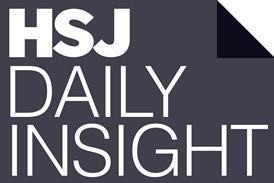Andy Cowper on government’s attempts to rebut media stories and a blatant attempt at numerical chicanery.
“The first rule of politics is that its practitioners need to be able to count”
For some time, I’ve described Matt Hancock as our first work experience health and social care secretary. It is not a bad summary: it captures his energetic tendencies towards the app-driven and the superficial pretty well.
However, another and more defining quality has been highlighted by his conduct throughout this pandemic.
A-ha!
There is something powerfully Alan Partridge about Mr Hancock. The gap between Hancock’s evident perception of his own abilities and what’s delivered in the real world is Dunning-Kruger-esque to the maximum.
If this is indeed, as prime minister Boris Johnson threatens, “a People’s Government”, then Mr Hancock must be “The People’s Chat-Show Host”. A-ha!
This week, we have seen Mr Hancock socially distancing himself from reality with typical enthusiasm.
At a time when the nation is short of new drama, we have at least had the spectacle of watching our health secretary trying to pull the “when in doubt, attack the media” move from the Trump playbook.
Mr Hancock made reference in the government’s daily press briefings to the “balance” of the recent BBC Panorama programme on PPE (their defence of this documentary is a study in concision and pertinence, in striking contrast to the government’s previous attempts to rebut bad media coverage). Mr Hancock has also taken to disputing the premise of journalists’ questions at the daily briefings.
Yesterday he disputed the Sunday Times’ lead story about shielding for the over-70s. In his protesting tweet he complained about “another factually wrong and misleading article on p1 of the Sunday Times. The clinically vulnerable, who are advised to stay in lockdown for 12 weeks, emphatically DO NOT include all over 70s. I’ve asked for an urgent correction”.
The problem is that, as Richard Dunstan pointed out, “Section 1 of the Health Protection (Coronavirus, Restrictions) (England) Regulations 2020, laid before Parliament by one Matt Hancock on 26 March, and which confirm the Prime Minister & CMO’s public advice of 16 March, state that “vulnerable person” is indeed thus defined. The Public Health England guidance (updated on 1 May) does the self-same thing.
If Mr Hancock really should know the difference between “clinically vulnerable” and “clinically extremely vulnerable”.
Confidence interval
The People’s Chat-Show Host excelled himself when claiming that the government had exceeded its target to achieve their not-following-the-science 100,000 covid-19 tests a day by the end of April. As HSJ exclusively revealed, this was “achieved” simply by dint of that old trick: recalculating the metrics of how they measured tests.
The Department of Health and Social Care sent out 27,497 home testing kits and a further 12,872 from “satellite centres” on Thursday and counted them towards the total.
As I pointed out last week, there is a set within this profoundly factional government who would happily see Mr Hancock play Colt Seevers – The Fall Guy - for the government’s performance. He has been described by multiple sources as “desperate” to see the number being hit.
Testing numbers from over the weekend demonstrate quite how artificial Friday’s allegedly target-busting performance was.
Mr Hancock told the daily briefing that he “did not recognise” the issues raised by HSJ’s report, which should worry those studying the after-effects of covid-19 infection. We know that anosmia has been a symptom, but we’d better put amnesia onto the checklist as well.
Earlier in the pandemic, Spectator editor Fraser Nelson revealed a cabinet sub-committee had tabled a memo saying the pandemic could lead to 150,000 deaths. The health secretary denied the story, only for the Financial Times to confirm it had said exactly that.
One very seasoned and senior observer of Conservative politicians remarked to HSJ that Mr Hancock’s political mentor was George Osborne and that, like the former chancellor, he “deals with an awkward story by denying it outright.”
Mr Hancock’s department doesn’t even seem to be able to cheat correctly: Sky News revealed that some of these home testing kits are useless because they don’t have return address labels.
I can’t improve on the words of former DH chief statistician Jon Hannah, who tweeted in response to HSJ’s revelations “I’m looking at a piece of monitoring data having its definition altered only days prior to the target in abject horror. I was already wary of shenanigans, but this really should be the end of public trust in DHSC stats”.
Yes, lying about numbers matters
Why does this obvious deceit matter? Firstly, because it damages trust in government. This is not a good look during a pandemic, during which the country must trust that the government is acting in the people’s best interests, rather than in its own. This pandemic does not absolve ministers and public officials form their legal duties to abide by the Nolan principles.
Indeed, it makes that need more acute. This behaviour effectively breaches all seven – selflessness, integrity, objectivity, accountability, openness, honesty and leadership – in one go.
The second reason is because the government is in government. This may seem obvious, but the penny is evidently yet to drop with the prime minister’s chief advisor Dominic Cummings.
Brexiteer MP Steve Baker shrewdly reminded us of Cummings’ strategy: get people to argue about the veracity of a number (“£350m a week to the EU” for Brexit; “40 new hospitals and 50,000 new nurses” in the general election campaign) so that they notice the number’s size.
That tactic had effects: Cummings has demonstrable success as a campaigner. But it is only effective in the context of a campaign. Government is not a campaign: these subversive tactics of asymmetrical warfare will undermine confidence in ways that will surely come back to bite.
The third reason is that the service and the system has delivered another heroic achievement under considerable pressure by increasing the testing infrastructure and capability so fast. By unnecessarily making himself a hostage to fortune with this non-science-following 100,000 tests number, Mr Hancock did the same to those around him. It has intensely irritated many senior NHS figures that their “boss” played silly buggers with the numbers in this fashion, therefore undermining the service’s efforts.
Fourthly, when a government uses such numerical chicanery quite this blatant, they are also telling the public sector what the acceptable standard for conduct is. This matters because once the NHS resumes more normal service, its previously-long waiting lists for access to care (RTT and non-RTT) will be even longer. They will need clearing. The government has de facto told the NHS that it would be fair game to use similar tricks.
None of this is good.



























9 Readers' comments